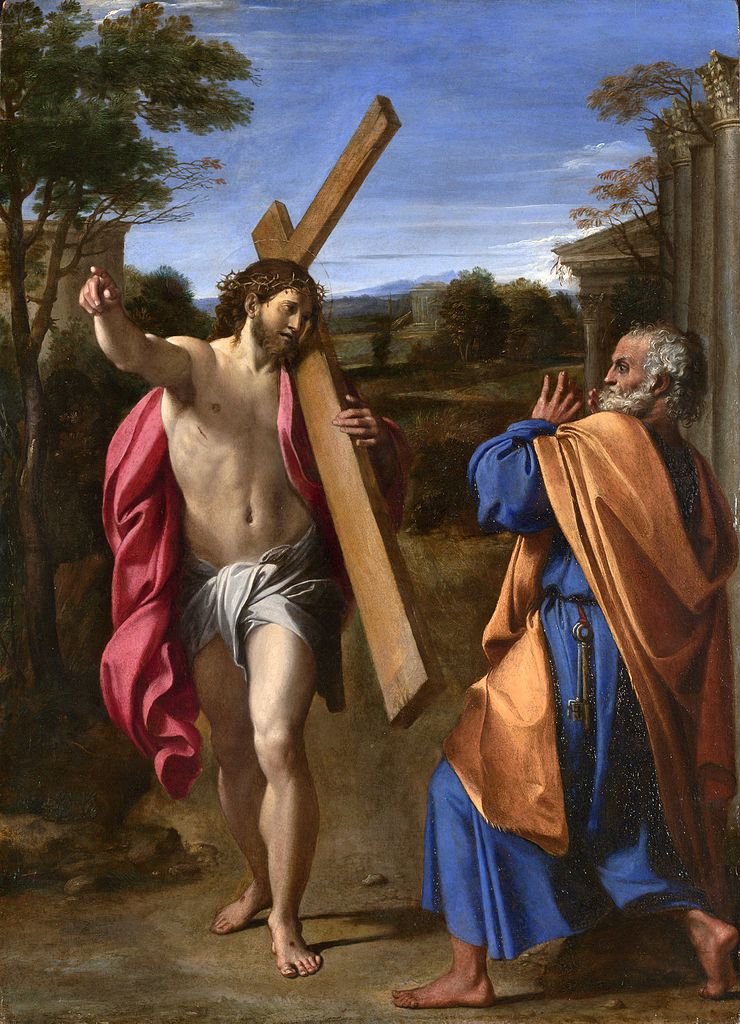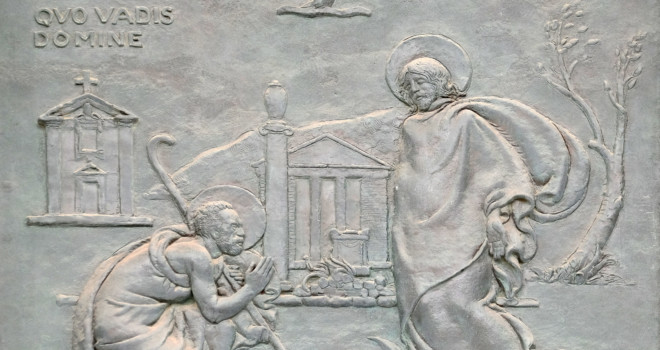Two summers ago, we took a trip to Italy, and after emerging from the Catacombs, we stumbled onto the Quo Vadis church. “Quo Vadis?” (“Where are you going?”) refers to a story about St. Peter, passed down through pious tradition.
In this story, Peter is fleeing Rome, where persecution is rampant. As he walks down the road that leads out of Rome, he encounters Christ…walking on the same road, but towards Rome. Surprised by this encounter, Peter asks Jesus, “Quo Vadis?” Wearily, Jesus looks at Peter and tells him, “I am going to Rome to be crucified again.”

As the story goes, this encounter led Peter to turn around and go back to Rome where he was indeed crucified.
The Relatable Apostle
I have always loved Peter’s “cringe-worthiness.” We’ve all had those moments in life when we say something we later regret, and end up re-playing it in our heads, over and over again. I love that Peter has so many of these moments in the Gospels (and must have had even more in his lifetime). Peter says the first thing he is thinking, for better or worse. He acts impetuously, but with conviction (like cutting off the ear of a man in Gethsemane). He does what he thinks is right, and he does it with a passion.
All of us can relate to these sorts of moments—moments when we are convinced that we have the right response to a situation, the perfect explanation in a disagreement, or the most soothing words in a tough moment. Unfortunately, we’re often wrong, just as Peter was.
The difference is in our response. Do we respond the way Peter does when we are wrong?
Peter is almost embarrassingly humble. As quickly as he errs, he repents. When he is wrong, he readily admits it. When an apology is needed, he offers it whole heartedly. And when he learns the way he should go, he heads running in that direction.
The Ardent Apostle
What shines through as the most defining characteristic of Peter, though, is that he is all in. When Peter puts his hand to the plough, he does his best to not look back. And if he does look back, he is quick to repent and try again.
There is an intensity to Peter, a sort of boldness, that I find overwhelming. When standing at his tomb, when gazing on the pillar that was likely the last thing he saw as he died (which now stands in St. Peter’s Square), when standing on the “quo vadis” road, that boldness of his was tangible. He didn’t just follow Christ—he ran after him.
Stumbling Towards Christ
Returning back to the “quo vadis” story we can see how both Peter’s ardor and “relatable-ness” come shining through. First, Peter thinks that fleeing Rome and persisting in his ministry (outside of the city) is the right thing to do—and he confidently goes in that direction. But, when confronted with the lovable Jesus, he turns back to Rome with equal confidence, even though it means certain suffering and death.
What is it that brings about this response in Peter? What is it about Christ that makes Peter so passionately, humbly, change his plans?
For Peter, love makes all the difference.
An attitude that I have often encountered in online Catholic circles is one of fearful obedience. Although it is good to obey the commandments and precepts of the Church, the gift of the incarnation is that we are invited to an encounter of God made man, and to loving relationship with him. The gift of our filial relationship to God the Father is at the root of our existence, a solace and point of strength. But through the incarnation, we are invited to not only be his children but also a member of the Church, the bride of the Son. I have been married for nearly twelve years, and my husband and I don’t “obey” each other in the way we would our parents. Our love is different from the love between parent and child. The deeper we grow in our union, the more we desire what the other desires. What motivates us is an ardent love for the other.
It is only an ardent love for another that could drive someone to martyrdom. This kind of love is less of a reflection on the perfection of Peter, and more a reflection of the authenticity of his encounter with Jesus. If you have ever had a moment in prayer—after Communion, during adoration, or some other time—when you have briefly glimpsed the lovable gentleness of Jesus, when you have briefly been pierced by his gaze, then you will understand what it is that made Peter behave with the boldness, conviction, and love that he did.
But the beauty of Peter is that…he wasn’t all that different from us. He made an awful lot of mistakes. He was a sinner. He was often inarticulate. He didn’t always know the right thing to do. But despite all of that, Jesus pierced his heart with that gaze of gentleness and love, and Peter let that change him.
The Universal Call to Holiness
All of us are familiar with the experience of trying to respond to God’s will for our lives, being met with suffering, and wanting to rapidly retreat. What can we do to be more like Peter?
Holiness is less about us, and more about letting God work in us. Becoming more like Peter does not require greater strength of will, more courage, or more discipline. Becoming more like Peter means looking for and receiving the loving gaze of Jesus in our lives. His gaze towards us is irresistible. He doesn’t need to utter a word to draw us after him.
We can’t earn our way to heaven. We can’t live holy lives apart from his grace and love. And we can’t face the hard things without seeking out and resting in the irresistible, lovable gaze of Jesus. With our eyes fixed on him, we, too, can turn back to face whatever cross he asks us to bear. Like Peter, we never bear it alone.
✠
image: Bronze door with the image of the life of St. Peter: “Domine, Quo Vadis?”, basilica of Saint Paul Outside the Walls (Rome) by Zvonimir Atletic / Shutterstock.com













